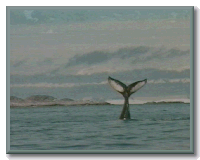|
None of the large whales breed in the Antarctic. Instead they use the productive waters of the Southern Oceans as a feeding ground, where they lay down vast reserves of blubber to sustain them during their stay in the less productive but warmer waters where they produce their young.
The toothed whales of the Antarctic, with one exception, are much less well known. The exception is the Sperm whale (Physeter catodon). Sperm whales seen in the Antarctic are invariably adult males. Because of their polygamous nature, there is a surplus of males in the breeding areas and some move to Antarctic waters where they feed on squid.
|
Probably the most conspicuous of the toothed whales in the Southern Ocean is the Killer whale (Orcinus orca). It is generally seen in small groups, where the adult males can be recognized by their very tall dorsal fins. Killer whales are generalized carnivores, taking a variety of food organisms; they are important predators of seals.
Two species of Beaked whales, Hyperoodon planifrons and Beradius arnuxii, are also commonly seen, but almost nothing is known of their biology. Several other species of small toothed whales have been seen in Antarctic waters, and one or two specimens have been collected, but there is a great gap in our knowledge here.
|
|
WANT TO LEARN MORE?
|
|
Websites
• Whales Links to information on the Blue, Humpback, Minke, Orca and Sei whales. • Prehistory More background information on the prehistory of Antarctica. • Antarctic Adventure 1997 Information on the geography and climate of Antarctica. |
|
Whales 1 2 |
![]()
